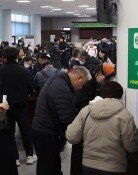Experts Fear Oil Spill Will Cause Long-Term Environmental Damage
Experts Fear Oil Spill Will Cause Long-Term Environmental Damage
Posted December. 13, 2007 03:07,
The biggest oil spill in South Korean history is likely to cause serious consequences in the long term, according to experts.
Even after the slick is removed, oil balls, oil treatment agents, volatile organic compounds, heavy metals, and other control chemicals will likely become secondary environmental risks.
Choi Ye-yong, the vice president of the ocean committee of the Korea Federation for the Environmental Movement (KFEM), said, We need to learn something from the previous Sea Prince (a Korean oil tanker) oil spill back in 1995. We should not just remove oil slick on the surface; we need to finish the job completely.
Serious Risks Posed by Chemicals Used in Clean-Up-
The most serious concern among environmental experts is oil clumps remaining in the sea after the surface crude oil slick is removed.
Oil clumps are formed from heavy materials when volatile materials are vaporized. They remain in the sea, killing fish and seaweed. Moreover, they contaminate plankton, destroying the food chain.
The problem is that there are few known ways to get rid of oil clumps or balls.
Oil treatment agents are one of the most serious secondary contaminants. The KFEM argued Wednesday that the government should stop spraying chemicals with planes and helicopters.
The poisonous spill treatment agents make it easy to mix oil into the water. Applying them may reduce the amount of oil slick on the surface, but the contaminants may come back to the shore someday.
Despite the side effects, treatment agents are being applied because they are cheaper than mats, and they show visible results by getting rid of the oil slick right away.
Throwing away or burning mats also causes environmental damage. It may pollute the air, and when it rains, the garbage is likely to be washed away, affecting a larger area.
An official of the Environmental Ministry said, Mats that absorb oil should not be burned.
Health Concerns for Residents and Volunteers-
The safety of residents and volunteers involved in the clean-up is another concern.
Some people are complaining of severe headaches and respiratory problems after being exposed to oil and oil treatment chemicals.
The Taean public health service said that 175 people got painkillers from nearby ambulances after complaining of headaches, nausea, and optical problems.
Roh Hyeong-geun, a respiratory physician who specializes in poisons at Gil Hospital, and who is volunteering near the affected area, said, The smell of poisonous carbon-hydrogen chemicals is likely to cause respiratory problems, affecting the central nervous system and bronchi.
Professor Roh added, Lengthy exposure to oil may lead to problems in senses and movement, pneumonia, and bronchitis. In particular, residents need to consult physicians to prevent those problems.
Natural Treasures May Be Affected for a Longer Period-
Experts worry about the potential damage to natural treasures and threatened species in Taean and the nearby Seosan region. The area has natural treasure No. 413, the Shinduri Coastal Dunes, Cheollipo Arboretum, and Cheonsuman habitats of migratory birds, the biggest in Asia, nearby.
The shore side of the dune has already been covered with oil. Lim Hee-ja of the KFEM said, If contaminated sand touches the dunes, threatened animals and plants will be seriously affected.
The sand dunes have the largest chunk of sweetbriers in the nation, and many flora and fauna threatened with extinction live in the dunes.
The first private arboretum in Korea, which has 13,000 kinds of species from 60 countries, is in a state of emergency. Choi Chang-ho of the arboretum said, The smell of oil is getting stronger. If the oil in the air penetrates into the pores of the leaves, plants will be seriously affected.







